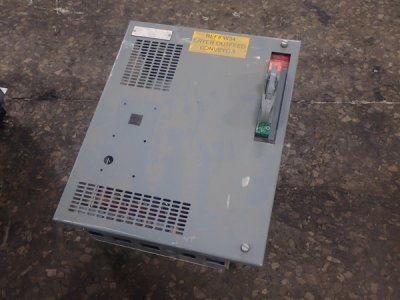My apologies Sir, I thought I read that you were using a VFD. An RPC, while accomplishing the same end result, is a "whole different ball game" in how that end result is accomplished. For a "non-electrical" person, I offer:
a treatise on the subject. Motors, specifically, are not covered far, it's just an introduction to the subject.
Let's start off on the basics, a
Motor Starter and what it does. To do that, consider a relay, any relay, such as what switches your headlights on. Then consider that you have 3 separate contacts for your 3 phases. Now make the contacts very large, from the size of a dime to the size of a silver dollar. That relay just became a "
Contactor". It's still a relay, just a very big one.
Now, the motor. . . A separate subject in and of itself, the reason it comes into the conversation is because most motors draw enormous current when starting. Depending on the motor and the load it is driving, that current may be 500-600%. That's 5 or 6 times the run current. Enough to melt fuses and cause the wires to rattle in the conduit. That current only lasts a few seconds, being a long time in motor circuits, but only a blip in people time. Fuses and circuit breakers aren't set up to handle that sort of current. Enter the "
Overload Deck". . .
The overload deck, I don't know the proper name, that's what it's called in the field, is just a specialized circuit breaker designed to handle motors and their current demands. There are many different types but most use a "eutectic" metal, one that changes from solid to liquid at a very specific temperature. These are called "solder pots" in the business. When current passes through the solid solder, it generates heat. Low current, low heat; large current, large heat. The amount of heat, determined by the amount of current, applied over a specified time will cause the solder to go euctic. How fast is a function of how much current. When the metal melts, a latch is released which causes a contact to open.
Now combine the
Contactor and an
Overload Deck on the same pan and you have a
Starter. The code calls for yada, yada, yada. . . The code is a required minimum for paid installers. The "code" is put out by the National Fire Protection Agency, and updated every three or four years. Why the code comes into play should be obvious by the issuing agancy. It keeps your shop from burning down, ruining the machines, and making the spouse angry. Should you inadvertantly violate the code and have a fire, your insurance can claim an "out" and you receive nothing but a heartache. So, follow the code where you can, it pays. .
Looking at your circuit overall, you will have a 240 volt, single phase circuit feeding your shop. It will have fuses(2) or a circuit breaker (CB) in the panel protecting the wires. Not the load, just the wires. . . In your shop, there may be a subpanel to isolate the different circuits. Including a "Rotary Phase Converter". The RPC should have a starter, after all it's just a motor and a few capacitors. (and maybe a kicker motor, depenting on who built it) The output of the RPC then feeds another, 3 phase, panel if you have more than one 3 phase load. From there, you feed the lathe, which may well be a system in and of itself. For a large, as in a repurposed industrial machine, there will be the main disconnect. That may or may not consist of a contactor and control circuits. It may well be just a (very large) switch. From there, you will have the
motor circuit, including a
starter and various controls.
What you are asking after is implemented with a latching, normally closed control switch, fairly light, interupting either the incoming line (a contactor) or better still interrupting the
starter. This is easily accomplished by wiring the switch in series with the coil of the starter. And you're done.
This entry is approaching the length of a small book. For this, I also apologize. Electricity is a deep subject, where you can study a lifetime and not learn it all. I'm living proof of that. . . Finding an electrician today is a challenge, many of the "electricians" licensed by the state are nothing more than "wire men". Do it right up front and it probably will pass inspection. The "code" will tell you what is right, you just need to understand the language. Hence my introduction above.
Bill Hudson
.



